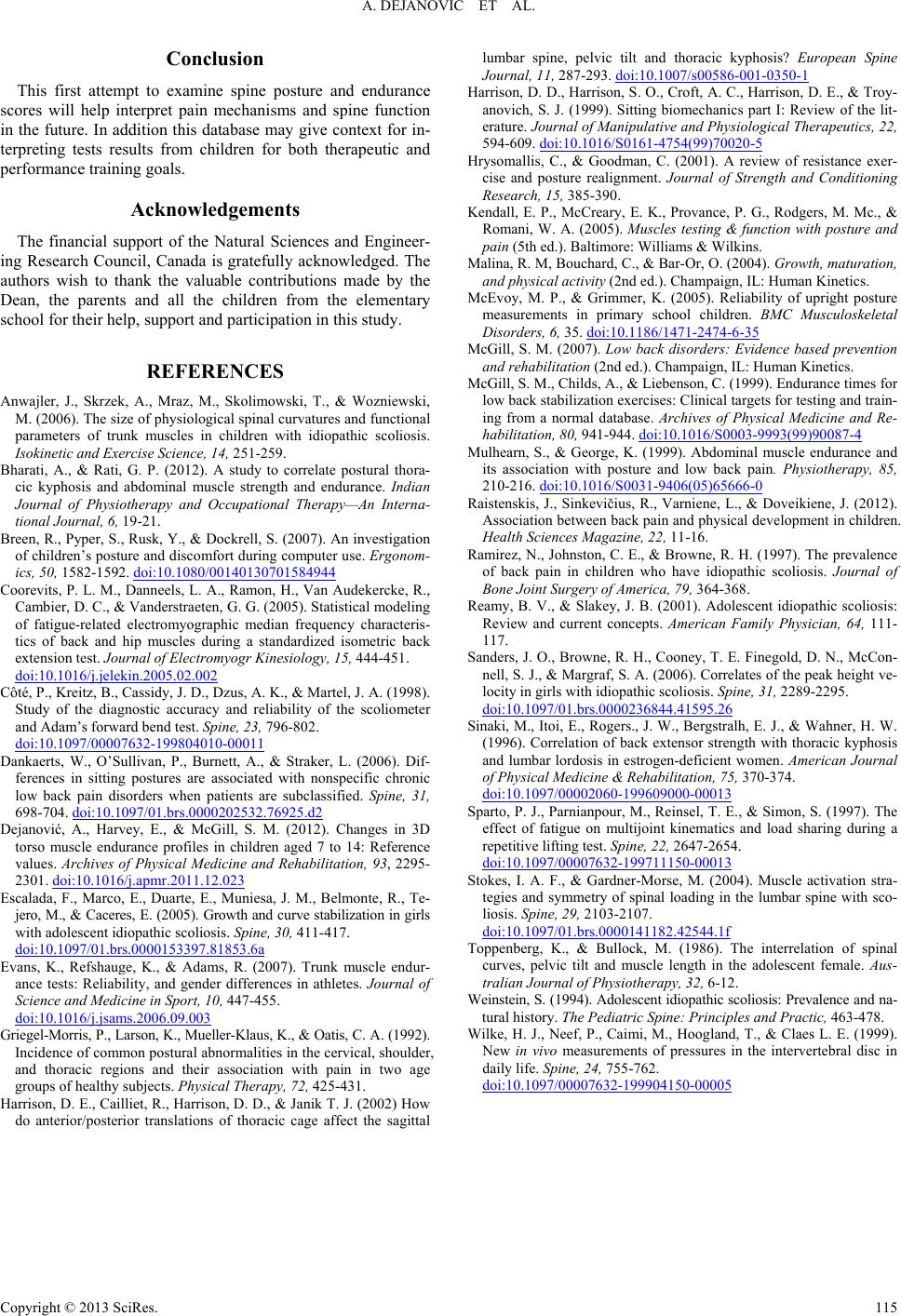
A. DEJANOVIC ET AL.
Conclusion
This first attempt to examine spine posture and endurance
scores will help interpret pain mechanisms and spine function
in the future. In addition this database may give context for in-
terpreting tests results from children for both therapeutic and
performance training goals.
Acknowledgements
The financial support of the Natural Sciences and Engineer-
ing Research Council, Canada is gratefully acknowledged. The
authors wish to thank the valuable contributions made by the
Dean, the parents and all the children from the elementary
school for their help, support and participation in this study.
REFERENCES
Anwajler, J., Skrzek, A., Mraz, M., Skolimowski, T., & Wozniewski,
M. (2006). The size of physiological spinal curvatures and functional
parameters of trunk muscles in children with idiopathic scoliosis.
Isokinetic and Exercise Science, 14, 251-259.
Bharati, A., & Rati, G. P. (2012). A study to correlate postural thora-
cic kyphosis and abdominal muscle strength and endurance. Indian
Journal of Physiotherapy and Occupational Therapy—An Interna-
tional Journal, 6, 19-21.
Breen, R., Pyper, S., Rusk, Y., & Dockrell, S. (2007). An investigation
of children’s posture and discomfort during computer use. Ergonom-
ics, 50, 1582-1592. doi:10.1080/00140130701584944
Coorevits, P. L. M., Danneels, L. A., Ramon, H., Van Audekercke, R.,
Cambier, D. C., & Vanderstraeten, G. G. (2005). Statistical modeling
of fatigue-related electromyographic median frequency characteris-
tics of back and hip muscles during a standardized isometric back
extension test. Jo u rnal of Electromyogr Kin e siology, 15, 444-451.
doi:10.1016/j.jelekin.2005.02.002
Côté, P., Kreitz, B., Cassidy, J. D., Dzus, A. K., & Martel, J. A. (1998).
Study of the diagnostic accuracy and reliability of the scoliometer
and Adam’s forward bend test. Spine, 23, 796-802.
doi:10.1097/00007632-199804010-00011
Dankaerts, W., O’Sullivan, P., Burnett, A., & Straker, L. (2006). Dif-
ferences in sitting postures are associated with nonspecific chronic
low back pain disorders when patients are subclassified. Spine, 31,
698-704. doi:10.1097/01.brs.0000202532.76925.d2
Dejanović, A., Harvey, E., & McGill, S. M. (2012). Changes in 3D
torso muscle endurance profiles in children aged 7 to 14: Reference
values. Archives of Physical Medicine and Rehabilitation, 93, 2295-
2301. doi:10.1016/j.apmr.2011.12.023
Escalada, F., Marco, E., Duarte, E., Muniesa, J. M., Belmonte, R., Te-
jero, M., & Caceres, E. (2005). Growth and curve stabilization in girls
with adolescent idiopathic scoliosis. Spine, 30, 411-417.
doi:10.1097/01.brs.0000153397.81853.6a
Evans, K., Refshauge, K., & Adams, R. (2007). Trunk muscle endur-
ance tests: Reliability, and gender differences in athletes. Journal of
Science and Medicine in Sport , 10, 447-455.
doi:10.1016/j.jsams.2006.09.003
Griegel-Morris, P., Larson, K., Mueller-Klaus, K., & Oatis, C. A. (1992).
Incidence of common postural abnormalities in the cervical, shoulder,
and thoracic regions and their association with pain in two age
groups of healthy subjects. Physical Therapy , 72, 425-431.
Harrison, D. E., Cailliet, R., Harrison, D. D., & Janik T. J. (2002) How
do anterior/posterior translations of thoracic cage affect the sagittal
lumbar spine, pelvic tilt and thoracic kyphosis? European Spine
Journal, 11, 287-293. doi:10.1007/s00586-001-0350-1
Harrison, D. D., Harrison, S. O., Croft, A. C., Harrison, D. E., & Troy-
anovich, S. J. (1999). Sitting biomechanics part I: Review of the lit-
erature. Journal of Manipulative and Physiological Therapeutics, 22,
594-609. doi:10.1016/S0161-4754(99)70020-5
Hrysomallis, C., & Goodman, C. (2001). A review of resistance exer-
cise and posture realignment. Journal of Strength and Conditioning
Research, 15, 385-390.
Kendall, E. P., McCreary, E. K., Provance, P. G., Rodgers, M. Mc., &
Romani, W. A. (2005). Muscles testing & function with posture and
pain (5th ed.). Baltimore: Williams & Wilkins.
Malina, R. M, Bouchard, C., & Bar-Or, O. (2004). Growth, maturation,
and physical activi ty (2nd ed.). Champaign, IL: Human Kinetics.
McEvoy, M. P., & Grimmer, K. (2005). Reliability of upright posture
measurements in primary school children. BMC Musculoskeletal
Disorders, 6, 35. doi:10.1186/1471-2474-6-35
McGill, S. M. (2007). Low back disorders: Evidence based prevention
and rehabilitation (2nd ed.). Champaign, IL: Human Kinetics.
McGill, S. M., Childs, A., & Liebenson, C. (1999). Endurance times for
low back stabilization exercises: Clinical targets for testing and train-
ing from a normal database. Archives of Physical Medicine and Re-
habilitation, 80, 941-944. doi:10.1016/S0003-9993(99)90087-4
Mulhearn, S., & George, K. (1999). Abdominal muscle endurance and
its association with posture and low back pain. Physiotherapy, 85,
210-216. doi:10.1016/S0031-9406(05)65666-0
Raistenskis, J., Sinkevičius, R., Varniene, L., & Doveikiene, J. (2012).
Association between back pain and physical development in children.
Health Sciences Magazine, 22, 11-16.
Ramirez, N., Johnston, C. E., & Browne, R. H. (1997). The prevalence
of back pain in children who have idiopathic scoliosis. Journal of
Bone Joint Surgery of America, 79, 364-368.
Reamy, B. V., & Slakey, J. B. (2001). Adolescent idiopathic scoliosis:
Review and current concepts. American Family Physician, 64, 111-
117.
Sanders, J. O., Browne, R. H., Cooney, T. E. Finegold, D. N., McCon-
nell, S. J., & Margraf, S. A. (2006). Correlates of the peak height ve-
locity in girls with idiopathic scoliosis. Spine, 31, 2289-2295.
doi:10.1097/01.brs.0000236844.41595.26
Sinaki, M., Itoi, E., Rogers., J. W., Bergstralh, E. J., & Wahner, H. W.
(1996). Correlation of back extensor strength with thoracic kyphosis
and lumbar lordosis in estrogen-deficient women. American Journal
of Physical Medicine & Rehabilitation, 75, 370-374.
doi:10.1097/00002060-199609000-00013
Sparto, P. J., Parnianpour, M., Reinsel, T. E., & Simon, S. (1997). The
effect of fatigue on multijoint kinematics and load sharing during a
repetitive lifting test. Spine, 22, 2647-2654.
doi:10.1097/00007632-199711150-00013
Stokes, I. A. F., & Gardner-Morse, M. (2004). Muscle activation stra-
tegies and symmetry of spinal loading in the lumbar spine with sco-
liosis. Spine, 29, 2103-2107.
doi:10.1097/01.brs.0000141182.42544.1f
Toppenberg, K., & Bullock, M. (1986). The interrelation of spinal
curves, pelvic tilt and muscle length in the adolescent female. Aus-
tralian Journal of Physiotherapy, 32, 6-12.
Weinstein, S. (1994). Adolescent idiopathic scoliosis: Prevalence and na-
tural history. The Pediatric Spine: Principles and Practic, 463-478.
Wilke, H. J., Neef, P., Caimi, M., Hoogland, T., & Claes L. E. (1999).
New in vivo measurements of pressures in the intervertebral disc in
daily life. Spine, 24, 755-762.
doi:10.1097/00007632-199904150-00005
Copyright © 2013 SciRes. 115